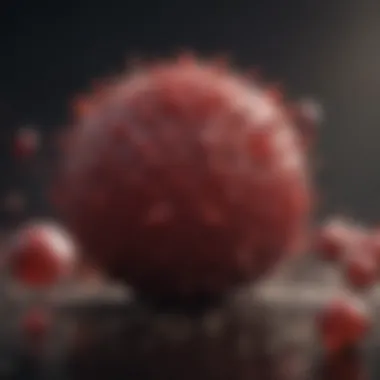T Cells and Multiple Myeloma: Insights and Implications


Intro
Multiple myeloma remains one of the most challenging hematological malignancies, characterized by unchecked proliferation of plasma cells. T cells, a crucial component of the immune system, play a significant role in the response to various diseases, including multiple myeloma. Understanding how T cells interact with malignant plasma cells can illuminate potential therapeutic avenues and provide deeper insights into the disease's pathogenesis.
The evolving landscape of immunotherapy, particularly T cell-based therapies, opens new doors for patients suffering from multiple myeloma. By exploring T cell function, the mechanisms that govern their action against cancer cells, and the persistent challenges in treatment, this article aims to provide a detailed analysis of the relationship between T cells and multiple myeloma.
Research Context
Background Information
Scientific understanding of the immune system has grown exponentially in recent years. T cells, including CD4+ and CD8+ subtypes, have emerged as central players in the immune response to cancer. In multiple myeloma, however, T cell function can be severely impaired, leading to inadequate responses to tumor cells.
Research indicates that multiple myeloma environments are often immunosuppressive, which hinders T cell activation and proliferation. The interactions between T cells and tumor microenvironment profoundly influence treatment outcomes. Thus, elucidating this relationship is crucial for developing effective immunotherapeutic strategies.
Importance of the Study
The significance of this study lies in its potential to pave the way for new, advanced therapies. Insights gained from analyzing T cell responses can lead to improved immunotherapies targeting cancer. Furthermore, enhancing T cell function may offer strategic advantages in combating multiple myeloma.
By articulating the interplay between T cells and multiple myeloma, this research underscores the necessity for further exploration into immune evasion mechanisms and T cell biology. Understanding these elements is paramount in addressing the overarching goal of achieving better clinical outcomes for patients.
Discussion
Interpretation of Results
Research findings suggest that reactivating T cells within the myeloma environment can significantly improve anti-tumor responses. When T cells are effectively harnessed, they can recognize and eliminate myeloma cells, leading to improved patient outcomes. Studies have shown that therapies combining T cell activation with other treatment modalities can provide synergistic benefits.
Comparison with Previous Research
Previous studies have documented the limitations of conventional therapies in treating multiple myeloma. However, the recent focus on T cell-mediated immunotherapy has generated promising results. Current approaches, such as CAR T-cell therapy, specifically target malignant cells, representing a paradigm shift in treatment.
Comparatively, findings from this research reinforce the critical impact of T cells over past strategies that relied heavily on chemotherapy alone. As such, the growing body of evidence advocating for T cell involvement in the treatment of multiple myeloma highlights an essential evolution in cancer therapy.
The journey of research in this area is far from complete. Ongoing investigations will be necessary to ascertain the full potential of T cells and refine the therapeutic strategies aimed at optimizing outcomes for patients with multiple myeloma.
Understanding Multiple Myeloma
Understanding multiple myeloma is essential because this particular type of cancer presents unique challenges in both diagnosis and treatment. Multiple myeloma emerges from abnormal plasma cells, leading to an overproduction of immunoglobulin or monoclonal proteins. This malignant disorder disrupts normal hematopoiesis, causing complications such as bone lesions and renal impairment. Recognizing its characteristics enables healthcare professionals to devise appropriate treatment strategies and tailor therapies for individual patients.
Definition and Characteristics
Multiple myeloma is defined as a malignant disorder characterized by the clonal proliferation of plasma cells in the bone marrow. These cells produce abnormal antibodies, also known as paraproteins. This condition can lead to symptoms like anemia, bone pain, and frequent infections. The typical characteristic of multiple myeloma is the presence of at least 10% of plasma cells in the bone marrow or the detection of a paraprotein in the serum or urine. A detailed understanding of these characteristics can aid in different therapeutic approaches for patients.
Epidemiology and Risk Factors
Epidemiology data reveals that multiple myeloma is more prevalent in older adults, particularly those over the age of sixty. The incidence rates vary globally, with higher occurrences noted in African American populations compared to Caucasian populations. Risk factors for multiple myeloma include genetic predispositions, exposure to certain chemicals, and possibly viral infections. Notably, obesity and a history of monoclonal gammopathy of undetermined significance (MGUS) also increases the likelihood of developing this cancer. Awareness of these risk elements is crucial for developing prevention strategies and further research into potential etiological factors.
Pathophysiology of Multiple Myeloma
The pathophysiology of multiple myeloma involves a complex interplay between malignant plasma cells and the bone marrow microenvironment. Malignant plasma cells can not only proliferate uncontrollably but also produce factors that suppress normal immune function. This process leads to bone destruction, as osteoclast activity is increased while osteoblast function declines. Furthermore, the continuous secretion of cytokines such as interleukin-6 enhances tumor growth and survival. Understanding these mechanisms helps researchers explore novel targeted therapies that can interrupt these pathways, leading to improved patient outcomes.


The Role of T Cells in the Immune System
T cells are a critical component of the adaptive immune system. These cells play essential roles in recognizing and responding to pathogens, including bacteria and viruses. In the context of multiple myeloma, understanding the function and diversity of T cells helps clarify their role in both disease progression and treatment approaches. Consequently, exploring the dynamics of T cells provides valuable insights into the mechanisms at play in multiple myeloma.
Types of T Cells
There are several distinct types of T cells, each performing specific functions in the immune response. The primary categories include:
- Helper T cells (CD4+ T cells): These cells assist other immune cells, enhancing the immune system's response to infections.
- Cytotoxic T cells (CD8+ T cells): These T cells kill infected or cancerous cells directly.
- Regulatory T cells (Tregs): They help maintain immune tolerance and prevent excessive immune responses, which can lead to autoimmunity.
- Memory T cells: These cells provide long-term immunity by remembering past infections, enabling a quicker response upon re-exposure.
The unique attributes of each T cell type contribute significantly to the overall effectiveness of the immune system, especially when addressing malignancies like multiple myeloma.
T Cell Activation and Function
T cell activation is a complex process that requires specific signals. Two primary signals are necessary: the recognition of an antigen presented by major histocompatibility complex (MHC) molecules and a second signal from costimulatory molecules.
Once activated, T cells undergo clonal expansion, creating a population of identical cells that can recognize the same antigen. Following this proliferation, T cells assume various roles within the immune response. They can directly kill tumor cells, provide support to other immune cells, or migrate to sites of infection. This versatility underscores their importance in combating diseases, including multiple myeloma.
Cytotoxic versus Helper T Cells
The distinction between cytotoxic and helper T cells is fundamental in immunology.
- Cytotoxic T cells are characterized by their ability to directly target and eliminate abnormal cells, such as those found in cancer. They achieve this by recognizing specific antigens presented by MHC molecules on tumor cells. Upon recognition, they release cytotoxic granules that induce apoptosis in target cells.
- Helper T cells do not kill directly. Instead, they play a crucial support role. By releasing cytokines, they enhance the activity of cytotoxic T cells, B cells, and other immune effector cells. This collaboration is vital for mounting an effective immune response against multiple myeloma and can offer insights into potential strategies for therapy.
Understanding the classifications and functions of T cell types is essential for developing effective immunotherapies against multiple myeloma.
In summary, T cells are integral to the immune response and hold significant relevance for the understanding and treatment of multiple myeloma. With specialized types and functions, they contribute to both the detection and destruction of malignant cells. This relationship is crucial for advancing both research and clinical applications in tackling this complex disease.
Interaction between T Cells and Multiple Myeloma
The interaction between T cells and multiple myeloma is a critical area of research in understanding how to effectively combat this malignancy. Myeloma, characterized by the uncontrolled proliferation of abnormal plasma cells, poses significant challenges to the immune system. T cells play an integral role in mediating immune responses, and their interaction with myeloma cells can have profound implications for disease progression and treatment efficacy.
Key elements to consider include how myeloma cells evade the immune system, the functional status of T cells in affected patients, and the influence of the tumor microenvironment on these interactions. These factors are crucial for developing strategies that not only target myeloma cells but also enhance the ability of T cells to mount an effective immune response.
Immune Evasion Mechanisms of Myeloma Cells
Multiple myeloma cells employ various immune evasion mechanisms to escape recognition and destruction by T cells. One prominent strategy is the expression of inhibitory ligands, such as PD-L1. This protein interacts with PD-1 on T cells, triggering exhaustion and diminishing their cytotoxic potential.
Additionally, myeloma cells can release soluble factors like IL-10 and TGF-β, which further suppress T cell activation. These mechanisms create an immunosuppressive environment that fosters tumor growth and survival. Understanding these evasion tactics is essential for designing therapies that can counteract these strategies, thereby restoring T cell functionality.
T Cell Dysfunction in Myeloma Patients
In patients with multiple myeloma, T cell functionality is often compromised. This dysfunction is characterized by altered T cell subsets, reduced cytokine production, and impaired cytotoxic activity. Research has shown that these defects correlate with disease progression and poorer patient outcomes.
Moreover, T cells from myeloma patients frequently exhibit signs of exhaustion — marked by upregulated inhibitory receptors and dysfunction in effector functions. This highlights the need for therapeutic strategies targeting T cell exhaustion to improve antitumor responses and overall patient survival.
Impact of Tumor Microenvironment
The tumor microenvironment plays a significant role in shaping T cell functions in multiple myeloma. It consists of various cellular components, including regulatory T cells, myeloid-derived suppressor cells, and mesenchymal stromal cells, all of which contribute to an immunosuppressive milieu.


This environment is not only conducive to tumor growth but also detrimental to T cell efficacy. The physical and biochemical signals present in the tumor microenvironment can lead to T cell anergy and apoptosis.
In summary, the interaction between T cells and multiple myeloma is multifaceted and requires comprehensive understanding. Insights into immune evasion mechanisms, T cell dysfunction, and the impact of the tumor microenvironment reveal significant challenges in treating this condition. By addressing these issues, there is potential for advancing therapeutic approaches to enhance T cell function and improve outcomes for patients affected by multiple myeloma.
"The relationship between the immune system and multiple myeloma is intricate and requires focused research to develop effective immunotherapies."
Therapeutic Implications
The therapeutic implications of T cells in the treatment of multiple myeloma cannot be overstated. Understanding how T cells interact with myeloma cells opens the door to innovative treatment strategies. T cells are central to immune responses and can be harnessed to target and destroy malignant plasma cells. This action not only reduces tumor burden but also enhances overall patient immunity. The interest in T cell therapy is growing, as it signifies a shift from traditional methods toward more tailored strategies.
Current Treatment Approaches
Current treatment approaches for multiple myeloma typically include a combination of chemotherapy, targeted therapy, and stem cell transplant. Common chemotherapeutic agents include bortezomib and lenalidomide.
- Chemotherapy: This is most often the first line of treatment. It aims to reduce the number of myeloma cells quickly.
- Targeted Therapy: Drugs like proteasome inhibitors and immunomodulatory agents work specifically on the pathways that these malignant cells exploit for their growth.
- Stem Cell Transplantation: For eligible patients, this can offer a long-term remission but is not suitable for everyone.
Role of Immunotherapy in Treating Myeloma
Immunotherapy involves stimulating or enhancing the body’s immune system to combat cancer. For multiple myeloma, this method aims to improve the immune response against cancer cells. Recently, monoclonal antibodies such as daratumumab and elotuzumab have emerged as crucial tools. These therapies achieve two objectives:
- Direct targeting of myeloma cells: By binding to specific antigens on cancer cells, they mark these cells for destruction.
- Immune system activation: By engaging with the immune system, they recruit T cells to mount an attack on the tumor.
The amalgamation of immunotherapy into standard care offers hope for improved patient outcomes.
Chimeric Antigen Receptor (CAR) T Cell Therapy
CAR T cell therapy represents a significant advancement in the field of immunotherapy for multiple myeloma. This technique involves genetically modifying T cells to express a chimeric antigen receptor, which specifically targets myeloma cells.
- Transformation of T Cells: Patient's T cells are extracted and engineered in the lab to recognize myeloma-specific antigens.
- Reinfusion: Once modified, these T cells are reinfused into the patient, where they proliferate and target the cancer cells efficiently.
Studies have shown that CAR T cell therapy can lead to remarkable responses in patients who have relapsed after standard treatments. However, this approach is still under extensive research to confirm long-term efficacy and safety.
Checkpoint Inhibitors and Their Potential
Checkpoint inhibitors are a class of drugs that provide a mechanism to enhance the immune response against cancer. In multiple myeloma, certain checkpoint inhibitors are being evaluated for their potential to leverage T cells more effectively against the disease.
- Mechanism of Action: These drugs modulate immune checkpoints, which are regulatory pathways that can turn off immune responses. By inhibiting these checkpoints, the T cells remain active and can attack cancer cells more robustly.
- Current Research: Agents like pembrolizumab and nivolumab are being assessed in clinical trials. Early results show they may work well in combination with other treatments to improve outcomes.
"Immunotherapy's integration into multiple myeloma treatment is an ongoing evolution that reflects the changing landscape of cancer care."
Challenges in T Cell-Based Therapies
The exploration of T Cell-based therapies in multiple myeloma brings significant promise, yet it is fraught with challenges that researchers and clinicians must address. Understanding these challenges is fundamental to improving treatment strategies for patients suffering from this complex cancer.
Overcoming Tumor-Induced Immune Suppression
Multiple myeloma creates a unique environment that can suppress the immune response. Tumor-induced immune suppression occurs when myeloma cells engage with various immune cells, leading to alterations that inhibit effective T cell function. These interactions can involve the secretion of immunosuppressive cytokines or the recruitment of regulatory T cells (Tregs), which further dampen the immune response.
To overcome this suppression, strategies that enhance T cell signaling pathways are being explored. Enhancing the efficacy of immune checkpoint inhibitors, such as pembrolizumab, may help restore T cell activity. Understanding how to disrupt the pathways that allow myeloma cells to evade the immune response is crucial. Researchers are investigating combinations of therapies, aiming to clear the suppressive microenvironment and make it more conducive for T cells to effectively target and kill malignant cells.


Managing Adverse Effects of Therapies
The effectiveness of T cell-based therapies often comes with a spectrum of adverse effects. Cytokine release syndrome (CRS) is a common reaction that can have severe implications for patient health. Symptoms of CRS can range from mild fever to life-threatening responses, necessitating careful monitoring and management.
In addition to CRS, neurotoxicity is another significant concern. This can manifest as confusion or seizures, and it can complicate the treatment landscape for patients already burdened with multiple myeloma.
Addressing these adverse effects requires a multidisciplinary approach. The implementation of supportive care strategies, prophylactic treatments, and close patient monitoring are vital. Developing predictive models to estimate risk may help in personalizing treatment plans, thus improving safety and patient outcomes.
Determining Patient Eligibility
Patient eligibility for T cell-based therapies is an intricate process influenced by various considerations. Not all patients may be suitable candidates for these treatments, and numerous factors must be weighed.
Inclusion criteria typically include patient age, overall health status, and prior treatment history. Co-morbidities may also impact eligibility, as they could complicate the management of potential side effects of therapy. A comprehensive assessment, often involving multidisciplinary teams, is essential to determine the safest and most effective treatment options for each patient.
Moreover, biomarkers of response are an emerging focus in defining eligibility. Identifying which patients are likely to benefit from T cell interventions requires ongoing research to develop reliable predictors of response. This targeted approach could enhance therapeutic outcomes and minimize unnecessary exposure to ineffective treatments.
Future Directions in Research
The future of research in the context of T cells and multiple myeloma is crucial for advancing therapeutic strategies and improving patient outcomes. Ongoing investigations aim to unravel the complexities of T cell interactions with myeloma cells, paving the way for novel treatment options and more targeted interventions. This section highlights three promising directions—innovations in genomic technologies, personalized medicine approaches, and collaborative research efforts—that hold the potential to reshape the landscape of multiple myeloma treatment.
Innovations in Genomic Technologies
Recent advancements in genomic technologies are transforming how researchers understand multiple myeloma at a molecular level. Techniques like CRISPR-Cas9 and next-generation sequencing provide unprecedented insights into the genetic alterations that drive myeloma. These innovations enable scientists to identify specific mutations and gene expressions that can affect T cell responses.
Furthermore, single-cell RNA sequencing is emerging as a critical tool to explore the heterogeneity within T cell populations. The ability to analyze many cells individually allows for a deeper comprehension of how myeloma affects T cell function. Understanding these dynamics can lead to new therapeutic targets and improve existing treatments.
Personalized Medicine Approaches
Personalized medicine is another promising area that emphasizes tailoring treatments based on the unique characteristics of both the patient and their disease. In the case of multiple myeloma, this approach focuses on the individual’s specific genetic and phenotypic profile.
By leveraging data from genomic technologies, clinicians can make informed decisions about which therapies may be most effective for a particular patient. This may include selecting specific immunotherapies that can engage T cells more effectively against the myeloma cells. As research continues to evolve, efforts are underway to create a more individualized treatment landscape for myeloma patients.
Collaborative Research Efforts
Collaboration among researchers, institutions, and pharmaceutical companies is essential in driving advances in multiple myeloma treatment. Interdisciplinary initiatives facilitate the sharing of resources, knowledge, and expertise. By fostering a collective approach to research, there is a greater likelihood of discovering breakthrough therapeutic options that utilize T cells more efficiently.
Teams working together can pool data from clinical trials, accelerate the validation of new findings, and establish better frameworks for evaluating treatment responses. These collaborative efforts are vital for addressing the multifaceted challenges posed by multiple myeloma and enhancing patient care.
The continual adaptation and integration of innovative research methods will be key in combating multiple myeloma effectively.
Culmination
The exploration of T cells in the context of multiple myeloma presents critical considerations for both research and clinical practice. Understanding T cell dynamics within the tumor microenvironment is essential for identifying new treatment pathways. These insights are vital for shaping future therapeutic strategies, especially within immunotherapy realms.
Immunotherapeutic approaches, particularly those utilizing T cells, hold significant promise for improving patient outcomes. As T cells play a crucial role in the immune response, their manipulation could affect tumor progression and resistance mechanisms. The potential benefits of optimizing T cell functions include enhanced disease response and extended survival rates for patients with multiple myeloma.
Moreover, addressing the challenges faced in current therapies reinforces the necessity for continuous research. Investigating immune evasion strategies, T cell dysfunctionality, and effective combinatory treatment approaches remains a priority. These efforts can lead to personalized treatments that cater to individual patient needs, enhancing efficacy.
In summary, the integration of T cell strategies within the framework of multiple myeloma not only contributes to the understanding of the disease but also encourages innovative treatment modalities. Sustained research in this area could redefine therapeutic outcomes and benefit patient populations significantly.
Summary of Key Findings
- T Cells and Myeloma: T cells encounter significant challenges due to immune evasion tactics employed by myeloma cells.
- Dysfunctional T Cells: Numerous patients exhibit T cell dysfunction, compromising treatment efficacy.
- Meaning of the Tumor Environment: The microenvironment around tumors influences T cell activities and responses.
- Chimeric Antigen Receptor (CAR) T Cells: CAR T cell therapy introduces tailored approaches that target myeloma cells directly.
- Immunotherapy Innovations: Advances in immunotherapy, such as checkpoint inhibitors, show potential in boosting T cell responses.
"Understanding the interplay between T cells and multiple myeloma brings us closer to effective therapeutic strategies while paving the way for innovations that address the disease's complex nature."















